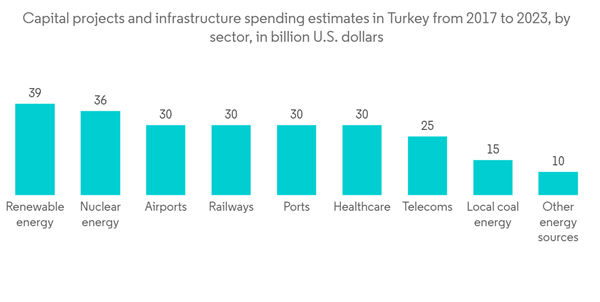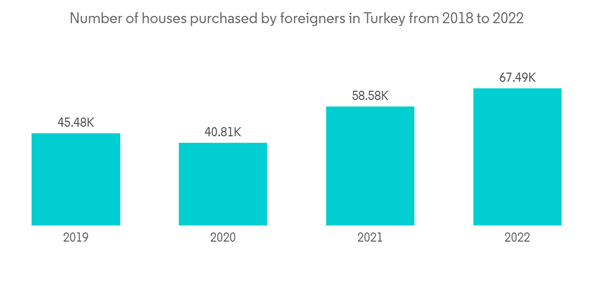The Turkey Construction Market size is estimated at USD 53.31 billion in 2024, and is expected to reach USD 68.43 billion by 2029, growing at a CAGR of 5.12% during the forecast period (2024-2029).
The government aims to reduce greenhouse gas emissions by 21%, compared to 8.1% in 2021 levels, by 2030 under the Intended Nationally Determined Contribution (INDC). Thus, to support this target, it is focusing on increasing the capacity of renewable energy across the country.
The military sites located in the affluent western part of the country will be moved to the east, while many of Istanbul’s military sites (over 50,000 acres) are likely to be redeveloped.
In January 2023, the Energy and Natural Resources Ministry unveiled the Turkish National Energy Plan and the Turkish Hydrogen Technologies Strategy and Roadmap, which were prepared within the framework of the 2053 net zero emission target. The ministry also plans to increase the share of renewable energy sources in energy consumption, from 16.7% in 2020 to 23.7% in 2035.
Antalya International Airport is undergoing an expansion to upgrade the infrastructure and expand passenger handling capacity. The JV paid EUR 1.81bn (USD 2bn) to DHMI as an upfront payment for the concession in March 2022. It is undertaking the expansion project with an estimated investment of EUR 765m (USD 840.2m), of which EUR 600m (USD 659m) is being invested in the first phase.
Construction on the first phase of the expansion commenced in January 2022 and is expected to be completed in January 2025. It will double the airport’s annual passenger handling capacity from 40 million to 80 million.
In an extension of the strong COVID-19 pandemic recovery, the economy grew at 5.6 percent in 2022. However, the economy has been losing momentum amidst a deteriorating external environment and heterodox monetary policies.
Turkey’s residential mortgage loans continue to rise. In November 2022, outstanding housing loans rose by 22.1% to TRY356.2 billion (USD 18.96 billion), following y-o-y growth of 7.5% in 2021 and 39.7% in 2020, based on figures from the (CBRT).
The residential and foreign buyers investing in innovative and modern residential apartments in Turkey, ongoing promotional campaigns by banks, and easing of home loan interest rates are some of the factors contributing to the increasing sales of residential flats in Turkey.
1,159,853 residential properties were sold in Turkey between January and October 2022, This is a 6.7% increase compare to the same period last year.
Housing sales to foreign buyers increased by 12% to 5,893 units during the same period. Istanbul, Turkey's most populous city, accounted for a major share of foreign buyer sales with 2,464 units.
This product will be delivered within 2 business days.
Key Highlights
- Due to the COVID-19 pandemic, the construction industry has taken significant hits in Turkey, with construction site closures, project cancellations, supply chain disruptions, and cash stagnation. Because the construction sector is interconnected with over 200 subsectors, any disruption in one of them is expected to cause a ripple effect in the construction sector.
- Construction is an especially important part of the Turkish economy, as it is in many other developing countries. As a result, disruptions in the aforementioned sector have had a greater negative overall impact than they would have in a less dependent, more developed economy.
- By 2023, the Turkish government plans to construct 2,000 kilometers of high-speed rail lines from Kars in northeast Turkey to Edirne in western Turkey, with China funding a portion of the project.
- The government also wants to increase renewable energy's share of electricity generation to 38.8% by 2023, up from 32.5% in 2018. The residential sector is expected to grow significantly over the forecast period because of the government's new urban development program and the country's interest rates being lowered.
- Turkey’s nationwide house prices rose by a whopping 189.9% in November 2022 from a year earlier, to an average of TRY 16,984 (USD 904) per square meter (sq. m.), according to the Central Bank of the Republic of Turkey (CBRT), following y-o-y rises of 64% in 2021, 32.6% in 2020, and 2.9% in 2019.
Turkey Construction Market Trends
Demand for Upgrading & Ongoing Infrastructure Projects to Boost the Construction Sector
According to the Turkish Statistical Institute (TurkStat), the average construction cost index rose by 103.3% in 2022. The industry is however expected to rebound at an average annual growth rate of 5% from 2024 to 2027, supported by investments in transport and renewable energy infrastructure projects.The government aims to reduce greenhouse gas emissions by 21%, compared to 8.1% in 2021 levels, by 2030 under the Intended Nationally Determined Contribution (INDC). Thus, to support this target, it is focusing on increasing the capacity of renewable energy across the country.
The military sites located in the affluent western part of the country will be moved to the east, while many of Istanbul’s military sites (over 50,000 acres) are likely to be redeveloped.
In January 2023, the Energy and Natural Resources Ministry unveiled the Turkish National Energy Plan and the Turkish Hydrogen Technologies Strategy and Roadmap, which were prepared within the framework of the 2053 net zero emission target. The ministry also plans to increase the share of renewable energy sources in energy consumption, from 16.7% in 2020 to 23.7% in 2035.
Antalya International Airport is undergoing an expansion to upgrade the infrastructure and expand passenger handling capacity. The JV paid EUR 1.81bn (USD 2bn) to DHMI as an upfront payment for the concession in March 2022. It is undertaking the expansion project with an estimated investment of EUR 765m (USD 840.2m), of which EUR 600m (USD 659m) is being invested in the first phase.
Construction on the first phase of the expansion commenced in January 2022 and is expected to be completed in January 2025. It will double the airport’s annual passenger handling capacity from 40 million to 80 million.
Residential Construction Activities Driven by Population Growth to Boost the Construction Sector
The construction sector in Turkey is expected to grow during the forecast period, driven by population growth, which is expected to drive residential construction. Türkey is the 19th largest economy in the world, with a GDP of roughly USD 906 billion. It is a member of the OECD and the G20 and an increasingly important donor of Official Development Assistance.In an extension of the strong COVID-19 pandemic recovery, the economy grew at 5.6 percent in 2022. However, the economy has been losing momentum amidst a deteriorating external environment and heterodox monetary policies.
Turkey’s residential mortgage loans continue to rise. In November 2022, outstanding housing loans rose by 22.1% to TRY356.2 billion (USD 18.96 billion), following y-o-y growth of 7.5% in 2021 and 39.7% in 2020, based on figures from the (CBRT).
The residential and foreign buyers investing in innovative and modern residential apartments in Turkey, ongoing promotional campaigns by banks, and easing of home loan interest rates are some of the factors contributing to the increasing sales of residential flats in Turkey.
1,159,853 residential properties were sold in Turkey between January and October 2022, This is a 6.7% increase compare to the same period last year.
Housing sales to foreign buyers increased by 12% to 5,893 units during the same period. Istanbul, Turkey's most populous city, accounted for a major share of foreign buyer sales with 2,464 units.
Turkey Construction Industry Overview
The Turkish market is highly competitive, with several players competing for the major share. The market is moderately concentrated. The key market players include Renaissance, Alarko, Polimeks, TAV, etc. Renaissance was ranked 28 in a listing of the world’s 250 largest Construction companies by ENR magazine.Additional Benefits:
- The market estimate (ME) sheet in Excel format
- 3 months of analyst support
This product will be delivered within 2 business days.
Table of Contents
1 INTRODUCTION
2 RESEARCH METHODOLOGY
4 MARKET DYNAMICS AND INSIGHTS
5 MARKET SEGMENTATION
6 COMPETITIVE LANDSCAPE
8 APPENDIX
Companies Mentioned (Partial List)
A selection of companies mentioned in this report includes, but is not limited to:
- Renaissance Construction
- Polimeks Construction
- Alarko Contracting Group
- TAV Construction
- Limak Insaat
- Enka Insaat
- Cengiz Construction, Industry & Trade Co.
- Yapi Merkezi Insaat
- Kolin Insaat
- Nurol Construction and Trading Co.
- Mapa Insaat
- Tefken Insaat
- Nata Insaat *
Methodology

LOADING...










